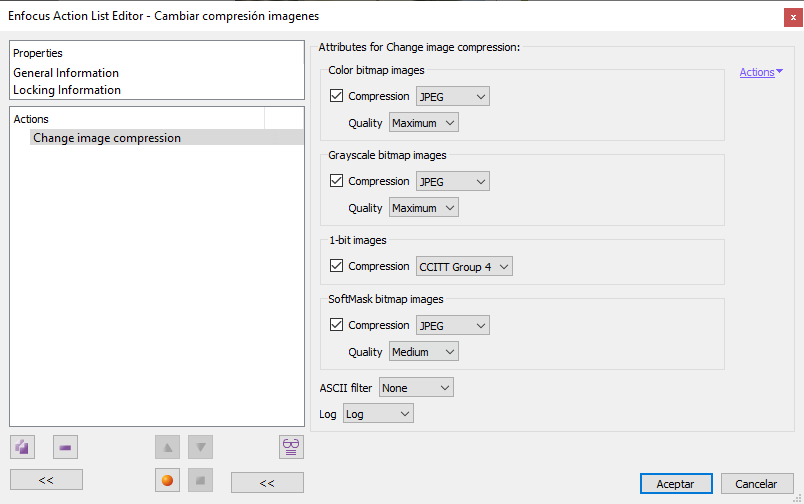
This Enfocus PitStop command allows us to change the compression of images (pixel objects, non-vector objects or objects with colour modes reserved for vector graphics such as some gradients or patterns). If nothing is selected, it affects all images within its reach.
If we apply a compression method to an image that already had one applied (even if it's the same one), the previous compression will be removed and the new one will be applied with the new values (even if they are the same ones).
Warning: Defects that the previous method may have caused in the affected images do not disappear. If the compression methods used involved losses (as is the case for JPEG, JPEG2000 and 4-bit ZIP), these losses will add up and the degradation of the quality of the images may become evident.
"Color bitmapped images": Refers to any image that is more than 1 bit deep (8, 16, 32...) and is in a colour mode other than "greyscale" (DeviceRGB, CalRGB, DeviceCMYK, RGB or CMYK with colour profile, Lab, Separation, DeviceN or indexed). Supported: "JPEG". "JPEG2000", "ZIP", "LZW" and "None".
"Grayscale bitmapped images": Refers to any image that is not 1 bit deep and is in "grayscale" colour mode (Calgray, DeviceGray or with a colour profile). Supported: "JPEG". "JPEG2000", "ZIP", "LZW" and "None".
"1-bit images": These are 1-bit deep images (so-called "bitmaps" in Photoshop). They support "CCITT" (Groups 3 and 4), "Runlength", "ZIP", "LZW" and "None".
"Softmask bitmap images". These are pixel images used as masks (from PDF level 1.4). Supported are: "JPEG". "JPEG2000", "ZIP", "LZW" and "None".
Warning: In all cases, choosing the "None" option removes the compression applied. If we do not want an image type to be altered by this command, we must uncheck the corresponding box.
The qualities and intensity of each algorithm can be varied in the majority of cases.

In addition to all these compression algorithms, there is the "ASCII Filter" option, with three options ("ASCCI hex", "ASCII 85" and "None"). Unless there is an explicit need to use one of these filters (usually related to the use of very old data transmission systems), the best option is "None".
[© Gustavo Sánchez Muñoz, 2025] Gustavo Sánchez Muñoz (also identified as Gusgsm) is the author of the content of this page. Its graphic and written content can be shared, copied and redistributed in whole or in part without the express permission of its author with the only condition that it cannot be used for directly commercial purposes (that is: It cannot be resold, but it can form part as reasonable quotations in commercial works) and the legal terms of any derivative works must be the same as those expressed in this statement. The citation of the source with reference to this site and its author is not mandatory, although it is always appreciated.